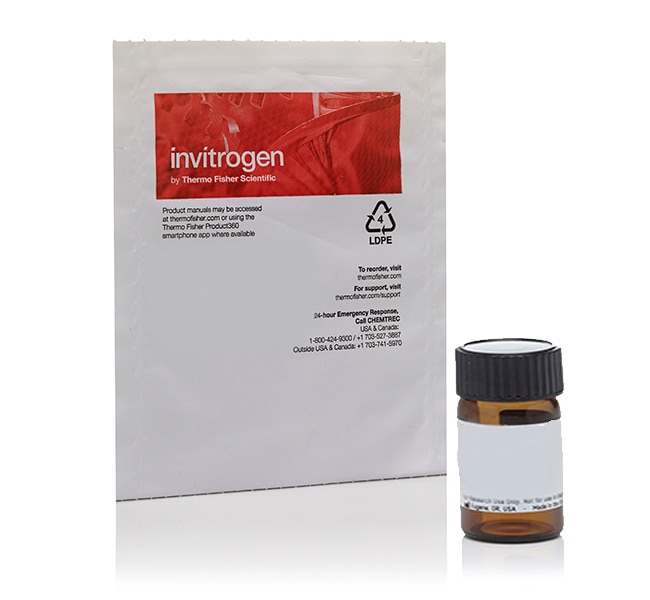Search Thermo Fisher Scientific

Certificados
SDS
Citas y referencias (19)
Invitrogen™
D-Biotina
D-Biotina: la d-biotina se une con alta afinidad a las proteínas de estreptavidina, avidina y Neutravidin™ de afinidad a laMás información
| Número de catálogo | Cantidad |
|---|---|
| B1595 | 1 g |
| B20656 | 10 ml |
Número de catálogo B1595
Precio (EUR)
177,00
Each
-
Cantidad:
1 g
Precio (EUR)
177,00
Each
D-Biotina: la d-biotina se une con alta afinidad a las proteínas de estreptavidina, avidina y Neutravidin™ de afinidad a la biotina.
Para uso exclusivo en investigación. No apto para uso en procedimientos diagnósticos.
Especificaciones
Tipo de productoBiotina (no conjugada)
Cantidad1 g
Condiciones de envíoTemperatura ambiente
Conjugadono conjugado
FormularioSólido
Línea de productosInvitrogen™
Unit SizeEach
Contenido y almacenamiento
Almacenar a temperatura ambiente.
Have questions about this product? Ask our AI assisted search.
Can I double digest my DNA using a Thermo Scientific conventional restriction enzyme and a FastDigest restriction enzyme?
What are key factors promoting star activity?
Unexpected DNA bands were observed on agarose gel electrophoresis after restriction digestion. What may have caused this?
What is the stability of Thermo Scientific restriction enzymes if they freeze-thaw during shipment?
Is there any other way to inactivate Thermo Scientific restriction enzymes (when thermal inactivation is not applicable) without using phenol/chloroform?
Show more FAQs for this product
This is an AI-powered search and may not always get things right. You can help us make it better with a thumbs up or down on individual answers or by selecting the “Give feedback" button. Your search history and customer login information may be retained by Thermo Fisher and processed in accordance with our
Privacy Notice.
Figuras

Chemical Structure

Diagram illustrating the use of streptavidin agarose and a DSB-X™ biotin bioconjugate in affinity chroma¬tography.
Los clientes que vieron este artículo también vieron
Documentos y descargas
Certificados
Buscar por número de lote o por número de lote parcial
N.º de loteCertificate TypeDateCatalog Number(s)
3222518Certificate of Analysis18 jun 2025B20656
3135781Certificate of Analysis06 abr 2025B1595
3148806Certificate of Analysis27 mar 2025B20656
3086981Certificate of Analysis19 nov 2024B20656
2984220Certificate of Analysis18 sept 2024B1595
Se muestran 5 resultados, busque arriba un certificado específico
Hojas de datos de seguridad
SDS
Product Information
Manual de Molecular Probes®
Preguntas frecuentes
D-biotin may be resolubilized in DMF (1-2 mg/mL), DMSO (49 mg/mL), ethanol (<1 mg/mL) or a buffer with a pH between >6 and <9. For long-term stability, D-biotin is stable in aqueous buffers at moderately acidic to neutral pH.
Find additional tips, troubleshooting help, and resources within our Cell Analysis Support Center.
Citations & References (19)
Search citations by name, author, journal title or abstract text
Citations & References
Abstract
High-performance liquid chromatographic determination of biotin in biological materials after crown ether-catalyzed fluorescence derivatization with panacyl bromide.
Journal:Anal Biochem
PubMed ID:1534471
This paper reports a high-performance liquid chromatographic (HPLC) technique to determine biotin in biological samples. Biotin and the internal standard dethiobiotin are converted into fluorescent derivatives by using panacyl bromide [p-(9-anthroyloxy)phenacyl bromide] as a fluorescence label. Biotin is extracted from biological tissue with trichloroacetic acid and the extract is purified
Easily reversible desthiobiotin binding to streptavidin, avidin, and other biotin-binding proteins: uses for protein labeling, detection, and isolation.
Journal:Anal Biochem
PubMed ID:12419349
'The high-affinity binding of biotin to avidin, streptavidin, and related proteins has been exploited for decades. However, a disadvantage of the biotin/biotin-binding protein interaction is that it is essentially irreversible under physiological conditions. Desthiobiotin is a biotin analogue that binds less tightly to biotin-binding proteins and is easily displaced by
Diaminobiotin and desthiobiotin have biotin-like activities in Jurkat cells.
Journal:J Nutr
PubMed ID:12730407
'In mammals, biotin serves as a coenzyme for carboxylases such as propionyl-CoA carboxylase. The expression of genes encoding interleukin-2 (IL-2) and IL-2 receptor (IL-2R)gamma also depends on biotin. Biotin metabolites are structurally similar to biotin, and their concentrations in tissues are quantitatively important. Here, the hypothesis was tested that biotin
Cellular uptake of biotin: mechanisms and regulation.
Journal:J Nutr
PubMed ID:10064315
'This review describes our knowledge of biotin transport in the small intestine of humans and other mammals and presents recent findings in the area. Previous studies have shown that biotin transport across the brush border membrane of the small intestinal absorptive cells occurs via a carrier-mediated, Na+ gradient-dependent, electroneutral mechanism.
Biotin transport through the blood-brain barrier.
Journal:J Neurochem
PubMed ID:3098919
'The unidirectional influx of biotin across cerebral capillaries, the anatomical locus of the blood-brain barrier, was measured with an in situ rat brain perfusion technique employing [3H]biotin. Biotin was transported across the blood-brain barrier by a saturable system with a one-half saturation concentration of approximately 100 microM. The permeability-surface area
19 total citations